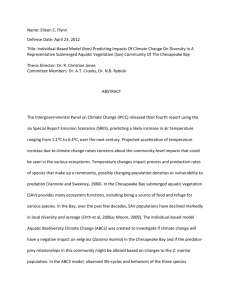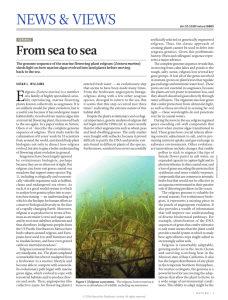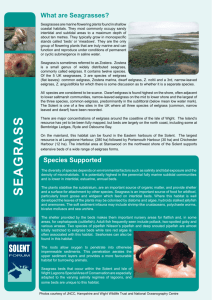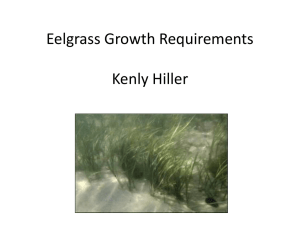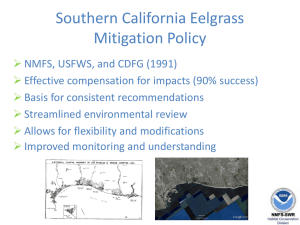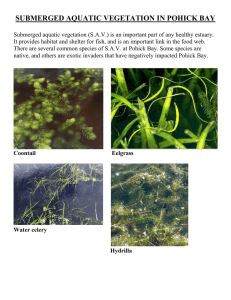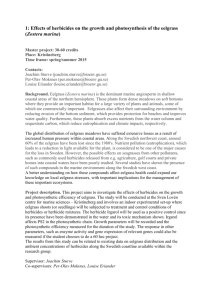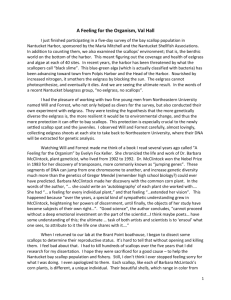definitions of harmful alteration, disruption or destruction
advertisement
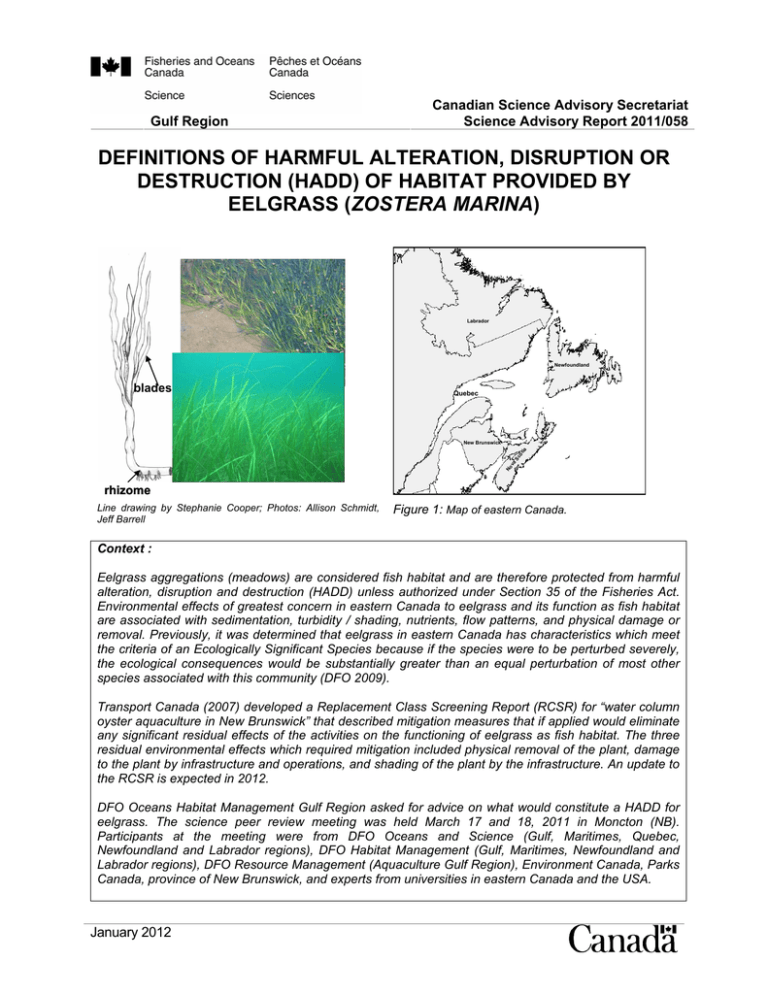
Gulf Region Canadian Science Advisory Secretariat Science Advisory Report 2011/058 DEFINITIONS OF HARMFUL ALTERATION, DISRUPTION OR DESTRUCTION (HADD) OF HABITAT PROVIDED BY EELGRASS (ZOSTERA MARINA) Labrador Newfoundland blades Quebec No va Sc ot ia New Brunswick rhizome Line drawing by Stephanie Cooper; Photos: Allison Schmidt, Jeff Barrell Figure 1: Map of eastern Canada. Context : Eelgrass aggregations (meadows) are considered fish habitat and are therefore protected from harmful alteration, disruption and destruction (HADD) unless authorized under Section 35 of the Fisheries Act. Environmental effects of greatest concern in eastern Canada to eelgrass and its function as fish habitat are associated with sedimentation, turbidity / shading, nutrients, flow patterns, and physical damage or removal. Previously, it was determined that eelgrass in eastern Canada has characteristics which meet the criteria of an Ecologically Significant Species because if the species were to be perturbed severely, the ecological consequences would be substantially greater than an equal perturbation of most other species associated with this community (DFO 2009). Transport Canada (2007) developed a Replacement Class Screening Report (RCSR) for “water column oyster aquaculture in New Brunswick” that described mitigation measures that if applied would eliminate any significant residual effects of the activities on the functioning of eelgrass as fish habitat. The three residual environmental effects which required mitigation included physical removal of the plant, damage to the plant by infrastructure and operations, and shading of the plant by the infrastructure. An update to the RCSR is expected in 2012. DFO Oceans Habitat Management Gulf Region asked for advice on what would constitute a HADD for eelgrass. The science peer review meeting was held March 17 and 18, 2011 in Moncton (NB). Participants at the meeting were from DFO Oceans and Science (Gulf, Maritimes, Quebec, Newfoundland and Labrador regions), DFO Habitat Management (Gulf, Maritimes, Newfoundland and Labrador regions), DFO Resource Management (Aquaculture Gulf Region), Environment Canada, Parks Canada, province of New Brunswick, and experts from universities in eastern Canada and the USA. January 2012 Gulf Region HADD Definitions for Eelgrass SUMMARY Eelgrass (Zostera marina) meadows by their vertical form and spatial coverage are important nearshore habitat for fishes (juvenile and adult) and invertebrates. As stress increases, an eelgrass meadow can respond by becoming patchy, less dense and/or occupying less of the available area. The effects of five stressors on eelgrass function as fish habitat were considered: sedimentation, turbidity, nutrients, flow regime, physical damage or removal. Thresholds for stressors that change the eelgrass function as fish habitat from a no effect case to a HADD case are proposed based largely on scientific studies but including an important component of expert opinion. There are very few studies that measure the fish habitat features of eelgrass meadows and how these vary with meadow form and structure (patchiness, density of shoots, area of contiguous bed). Landscape features including connectivity and contiguity of habitat on a bay scale are an additional and higher level of consideration. The knowledge gaps and uncertainties make it difficult to assign stressor threshold values to the HADD categories. Only the destruction HADD threshold can be well defined. Stressors often occur simultaneously and the thresholds for individual stressors are likely to be lower when they occur in combination. INTRODUCTION Eelgrass (Zostera marina L.) is a common highly productive perennial aquatic plant that can form extensive intertidal and subtidal beds in temperate estuaries and coastal areas. Eelgrass in eastern Canada has characteristics which meet the criteria of an Ecologically Significant Species because if the species were to be perturbed severely, the ecological consequences would be substantially greater than an equal perturbation of most other species associated with this community (DFO 2009). Eelgrass, in terms of an aggregation (also referred to as a bed or meadow), is also considered fish habitat and is therefore protected from harmful alteration, disruption and destruction (HADD) unless authorized under Section 35 of the Fisheries Act. Its function as a habitat structure includes providing cover from predation, reducing local current regimes, and increasing secondary productivity by adding to local habitat complexity and surface area. The HADD designations refer to the habitat value of eelgrass meadows for fish and invertebrates, not to the intrinsic ‘health’ or viability of an eelgrass meadow. As an eelgrass meadow is increasingly harmed by a stressor, the consequence to its habitat value will move from disruption to harmful alteration to destruction. The term “fish” as used in this document is defined in the Fisheries Act, and encompasses a broad range of organisms including “fish, shellfish, crustaceans, marine animals and any parts of shellfish, crustaceans, or marine animals, and the eggs, sperm, spawn, larvae, spat and juvenile stages of fish, shellfish, crustaceans and marine animals” (Fisheries Act, (2)). Fish habitat is defined in the Fisheries Act as “spawning grounds and nursery, rearing, food supply 2 Gulf Region HADD Definitions for Eelgrass and migration areas on which fish depend directly or indirectly in order to carry out their life processes” (Fisheries Act, 34(1)). Harmful Alteration, Disruption and Destruction (HADD) is defined in DFO’s fish habitat management policy in increasing order of severity as follows (DFO 2006): Disruption - Any change to fish habitat occurring for a limited period that reduces its capacity to support one or more life processes of fish. Harmful alteration - Any change to fish habitat that reduces its long term capacity to support one or more life processes of fish but does not permanently eliminate the habitat. Destruction - Any permanent change of fish habitat that renders it completely unsuitable for future production of fish, regardless of the means employed in causing the change (e.g. by removal, infilling, blockage etc). To assist in the risk assessment of effects of projects on fish and fish habitat, DFO Habitat Management Gulf Region has asked for advice on what would constitute a HADD for eelgrass, i.e. at what point the function of eelgrass as fish habitat is compromised. Specifically, advice is being requested on the following questions: 1) how to scale (from no effect to high) the environmental effects of sedimentation, turbidity or light penetration, nutrients, flow regime, and physical removal on eelgrass form, and 2) how sensitive is the fish habitat function provided by eelgrass to the environmental stressors. ANALYSIS Eelgrass as fish habitat Eelgrass (Zostera marina) is one species in the large family of seagrasses distributed throughout the world. Where possible, studies specific to eelgrass were considered in this assessment but studies of aquatic organism communities in seagrasses more generally are included as they describe the general functional characteristics of seagrasses as fish habitat and responses to environmental stressors. Eelgrass meadows by their vertical form provide structural complexity to the nearshore underwater landscape and are widely recognized as important nearshore habitat for fishes (juvenile and adult) and invertebrates (Vandermeulen 2005; DFO 2009). The beds provide refuge from predation, enhance food resources, reduce local current velocities (allowing for settlement of organisms) and increase secondary productivity by adding to local habitat complexity and surface area. Eelgrass physically changes its environment by producing oxygen, absorbing nutrients, reducing suspended sediments, stabilizing sediment thereby buffering shorelines from erosion, filtering contaminants, storing organic matter and producing dissolved oxygen (DFO 2009; Vandermeulen 2009). None of the other structuring habitats (oyster beds, macroalgae, or cobble reefs for example) provide these functions to the extent that eelgrass does. A previous review determined that eelgrass met the criteria for an Ecologically Significant Species (ESS) in Atlantic Canada (DFO 2009). In a simplified model, eelgrass beds can respond to stress in three ways: changes in patchiness, reduced leaf bundle density (shoot density), or a reduction in area covered, or combinations of these (Fig. 2). The value of eelgrass as fish habitat would vary accordingly. 3 Gulf Region HADD Definitions for Eelgrass Patchiness Density destroyed pristine Area covered Figure 2. Simplified framework model of changes in form of eelgrass beds in response to stress. As a stressor increases in intensity the eelgrass bed can be altered from the pristine condition on the far left (a continuous high density bed fully occupying the available area) to complete destruction (far right). If stressor intensity is reduced the paths can be reversed, as indicated by the arrows along each path. Patchiness A contiguous bed of eelgrass is considered to have an areal extent of 100’s to 1,000’s of square meters while patchiness is considered on a spatial scale of 10’s of square meters. Patchiness in seagrass systems is commonly defined as a surface differing from its surroundings in terms of size, shape, habitat, heterogeneity and/or boundary characteristics (Eggleston et al. 1998). Research on patchiness in seagrass systems is concentrated around patch size and edge effects. Habitat fragmentation involves the simultaneous loss of habitat and alteration of habitat configuration through the division of contiguous beds and patches into smaller, more numerous units, with proportionally more edge to interior. The resultant seagrass landscape is one in which mean habitat patch size is low and mean patch isolation is high. It has been suggested that a loss of about 50% of the eelgrass cover corresponds with a transition in function and habitat structural integrity from that of a contiguous bed to that of distinct patches (Fonseca and Bell 1998). The effects of fragmentation (declining patch size) on faunal assemblages depend on the organisms’ responses to, and preferences for, edge versus interior conditions. Mobility, size and trophic level each may influence the responses of species to structural complexity and edge effects. For example, structural complexity (expressed as shoot density) generally increases from edge of patches to the interior. Some studies report a lower fish species richness in edge compared to core regions of larger beds, but constant species richness over all regions of smaller beds, in which richness was similar to those of the core regions of larger beds. This contrasts to other studies that have found a positive edge effect (increased species diversity and abundance at the edges of a patch or edge). For mobile species that forage over large areas, fragmentation may actually increase the numbers of individuals found within edges. High levels of fragmentation may correspond to thresholds below which faunal abundance, diversity and survival are reduced (Reed and Hovel 2006). An eelgrass removal/fragmentation experiment conducted in 16 m2 experimental plots induced precipitous declines in fish and decapod species richness and abundance as well as changes in community composition at 90%, but not at 50% eelgrass removal (Reed and Hovel 2006). Similarly, dramatic changes in 4 Gulf Region HADD Definitions for Eelgrass habitat function and population persistence of a wide range of terrestrial taxa have been shown to result from 50-80% habitat loss. Area/size of eelgrass bed Size of the eelgrass bed may be important. Infaunal diversity and abundance were greater in a bed of 1,000 m2 area than in 1-200 m2 patches (Mills and Berkenbusch 2009). The impact of eelgrass bed size, or the disappearance of beds, is reduced when the habitat that replaces eelgrass is of equivalent quality. Heck et al. (2003) in their review of more than 200 papers examining the nursery role of seagrass meadows to commercially important fish (finfish and shellfish) species found results to be consistent with the expectations that abundance, growth and survival were greater in seagrass habitats than unstructured habitats, however there were few significant differences when compared to other structural habitats such as oyster or cobble reef or macroalgal beds. That is to say that habitat structure per se, not necessarily the type of structure, was important as nursery habitat. In studies with reduction of seagrass beds over time, no significant decreases in harvests were seen for commercially important species, but there was a decrease in juveniles of these species. In Atlantic Canada there is no substitute structuring habitat with the same function as eelgrass that can grow on soft-bottom intertidal and subtidal areas within the salinity ranges occupied by eelgrass, and in the absence of eelgrass, these areas would consist of sand or mud flats (DFO 2009). Once the transition from eelgrass to bare substrate takes place, the structure, abundance, diversity and age distribution of the faunal community changes. Studies consistently show greater abundance of fishes and invertebrates in eelgrass relative to unvegetated, unstructured, habitats. Density With increases or decreases in shoot density, there can be changes in the benthic community and changes in trophic interactions within the eelgrass community are inevitable. Generally the scientific literature indicates that even at low levels of density the eelgrass beds can provide benefits as fish habitat. Density of plant shoots can indirectly affect predation rates in seagrass communities and a nonlinear relationship exists between predation and shoot density. High densities (high biomass) of shoots can impair “chase and attack” predator foraging success. For “ambush predators” success can be high in dense eelgrass beds and as shoot density decreases, predation success decreases. While specific thresholds of decreased predator efficiency are difficult to identify, the evidence indicates that even sparse densities of shoots can serve as a shelter against predators. Hughes et al (2002) found that fish abundance, biomass, species richness, dominance and life history diversity decreased significantly along a gradient of decreasing eelgrass habitat complexity (a combination of eelgrass density and canopy height; zero complexity = no eelgrass; low complexity < 100 shoots/m2 or 100 g wet weight/m2; high complexity the low complexity values). The same trend occurred in both resident species and nursery species. The level of resolution of the comparison did not permit identification of a threshold. Fish assemblages in beds that had suffered a loss in habitat complexity did not recover within 3 to 5 years. 5 Gulf Region HADD Definitions for Eelgrass A study conducted in Newfoundland on the use of eelgrass beds by age 0+ Atlantic cod (Gadus morhua) shows that cod juveniles are found almost exclusively in eelgrass beds and suggests that a threshold level of eelgrass density in the range of 720-1000 shoots/m2 provides a significant reduction in predation risk to the age 0+ cod (Gotceitas et al. 1997). Effects of environmental stressors on eelgrass beds The conceptual model in Figure 2 provides a way to describe the responses of eelgrass meadows to stress. As stress increases, an eelgrass meadow can respond by becoming patchy, less dense (in terms of shoot/leaf bundle density or leaf count per unit area) or occupy less of the available area. If stress is unrelenting and intense, the beds can be destroyed along those pathways. If stress is reduced, eelgrass beds may fully recover to their pristine state or some point close to it by reversing their position along the pathway. Eelgrass can respond to stress in other ways, such as reduced growth rate of individual leaves or decreased photosynthetic rate, however, this review addresses habitat scale (meadow) responses of eelgrass to stressors rather than individual leaf scale responses. Five stressors are considered. 1. Sedimentation: regardless of source. Eelgrass beds can be damaged by excessive sediment deposition and erosion. 2. Turbidity: includes light penetration or water clarity. Eelgrass is a photosynthetic plant and has a high minimum light requirement for survival. The maximum depth of water colonized by eelgrass is determined by the amount of light reaching the bottom. Increased turbidity from sediment input or re-suspension of sediments reduces water clarity, but so does increased nutrients which promote phytoplankton growth in the water which also reduces water clarity and ultimately, light reaching the plants. 3. Nutrients: eelgrass is intolerant of anoxic and eutrophic conditions. Overgrowth with epiphytes and nuisance macroalgae in response to excess nutrients as well as loss of water clarity are the main issues. 4. Flow regime: includes current speed and patterns. Eelgrass grows best at moderate water currents. High currents are disruptive of eelgrass and it is unlikely to occur as contiguous beds at high current conditions. 5. Physical damage or removal from various sources including dredging, boat mooring scour, docks, piers, propeller scars, and fishing practices (dragging, digging, trapping). Each of these stressors will have an effect upon eelgrass based upon the stressor’s intensity, duration, area scale and frequency. Scientific studies in which the intensity of the stressor was identified and the duration was at least several weeks were included in the review. Descriptions of area scale and frequency were overall rarely indicated or studied. Sedimentation If eelgrass is overwhelmed by a rapid sedimentation event, it does not survive the burial particularly well. At a burial depth as low as 25% of the average aboveground plant height (and as low as 4cm), the probability of mortality can exceed 50% and the probability of mortality increases rapidly when burial was 50% of plant height (8cm), this mortality occurring in less than a month. Complete mortality did occur at 75% burial (Mills and Fonseca 2003). 6 Gulf Region HADD Definitions for Eelgrass Turbidity Eelgrass requires quite high light levels to survive and Zostera species do not tolerate low light levels for long compared to other seagrasses. The plants may only survive for a month or less at minimum light requirement levels. Turbid waters are one of the main factors causing the loss of eelgrass. As the turbidity stress increases the plants will reduce their carbon reserves and start to lose biomass, growth, shoot density and area coverage which can ultimately lead to destruction. Chronic high spring season turbidity was cited as the primary factor preventing the reestablishment of healthy eelgrass beds in a portion of Chesapeake Bay (Moore et al. 1996). Spring total suspended solids in the water column were often well over 20 mg l-1 at the worst upstream site and led to severe light attenuation. Eelgrass plants can persist at surface irradiance (SI) levels of 58% and above, are light limited at 34% SI, and severe mortality (81%) of eelgrass was reported at 11% SI (Ochieng et al. 2010). A value of 10 to 20% of surface light is considered the minimum light limit for eelgrass survival (Short et al. 1995). The water column itself does not have to be ‘turbid’ to shade marine macrophytes. Eelgrass can become directly shaded at their surfaces by a cover of epiphytes or by excessive amounts of particulate material settling on leaves or by overgrowth of nuisance seaweeds (macroalgae) that reduce light reaching the plants and that can smother eelgrass. Shaded eelgrass growing in high-organic sediments may be incapable of reoxidizing sediment sulphides, leading to anoxic and sulphide laden pore water conditions which may further reduce eelgrass growth and survival. Nutrients Short and Wyllie-Echeverria (1996) conclude that anthropogenic nutrient inputs to coastal areas is the primary cause of the present world-wide decline in seagrasses. Elevated nutrient concentrations can have direct physiological effects on marine plants (e.g. elevated tissue residue concentrations, increased growth and development of reproductive tissues, but, at very high nutrient levels plant toxicity). Eelgrass is very effective in removing and utilizing for shoot growth nitrogen from the sediment and the water column. Growth of Zostera can be reduced by naturally occurring nutrient limitation in oligotrophic environments. Eelgrass may be affected by direct toxicity at even ‘low’ nitrate loading rates of 3.5 µM NO3¯-N day-1 and elevated nitrate levels in nearshore waters due to eutrophication (c.a. 5 to 10 µM NO3¯-N day-1) will have a direct adverse effect on Zostera marina. There are a number of indirect effects of elevated nutrient concentrations on eelgrass. The eutrophication of coastal waters can lead to the stimulation of phytoplankton growth and a subsequent increase in water column turbidity which can negatively impact eelgrass and macrophyte growth (see Turbidity section above). Under normal conditions, grazers remove epiphytic algae from seagrass leaves however, under eutrophic conditions, epiphytes and macroalgae can seasonally outgrow grazing with resulting detrimental effects to Zostera. The inhibitory effect of epiphytes comes about by shading, interference with nutrient uptake, and interference with carbon uptake. 7 Gulf Region HADD Definitions for Eelgrass Eelgrass rhizomes are effective in removing nutrients from sediment. If Zostera dies back in an area due to eutrophication of the water column, sediment nutrient concentrations are likely to increase. Eutrophication can cause elevated carbon content in sediment, lowered oxygen concentrations to the point of anoxia, elevated hydrogen sulphide concentrations, negative redox potential, mobilization of metals, and mobilization of nutrients. These changes may result in negative effects for rooted marine plants like seagrass. Eelgrass rhizomes are protected from damage by hydrogen sulphide in sediment pore water via a supply of oxygen from the leaves to the rhizomes along hollow channels called lacunae. At water column oxygen levels below 20% of air saturation, the lacunal system cannot provide enough oxygen for sulphide re-oxidation, and the tissue concentration of hydrogen sulphide in the rhizomes rises rapidly. The eutrophication effects of elevated sediment sulphide and reduced light availability are additive in their inhibitory effect on eelgrass. A combination of high sediment sulphide concentration (800 – 1000 µM) and low light (15% of solar irradiance) were found to reduce photosynthetic rates to about one tenth that observed under high light (50% of solar irradiance) plus low sulphide (below 400 µM) conditions. Elevated sediment sulphide has the potential to reduce photosynthetic rates at any light level. The negative effects of the macroalgal canopy under nutrient loading are the primary mediator for eelgrass declines in shallow water lagoons (Hauxwell et al. 2006). Shifts in species composition can occur along the eutrophication gradient. As nutrient loading increases, slow growing seagrasses and macroalgae are replaced by fast growing nuisance algae, with phytoplankton dominating at high loading rates in subtidal systems (>2m). Eelgrass survival rates showed a decreasing trend with algal biomass, especially at higher temperatures (26 and 30 °C). In general, nutrient loading rates of approximately ≤12 kg N ha-1 yr-1 had no major effect on eelgrass beds in Waquoit Bay estuaries, about 30 kg N ha-1 yr-1 lead to substantial eelgrass loss (80 to 96% of bed area) and ≥ 60 kg N ha-1 yr-1 caused total disappearance (Short and Burdick 1996; van Katwijk et al. 1999; Hauxwell et al. 2003; Hauxwell et al. 2006; Fox et al. 2008). A reduction in dissolved oxygen concentration in the water column can come about from eutrophication. The meristematic region of eelgrass leaves will quickly go anoxic if the water column is anoxic. This may be a key factor in seagrass die-off under low oxygen conditions (Greve et al. 2003). In laboratory experiments conducted at 20 °C, negative effects of anoxia occurred after 12 h (affecting photosynthesis) and 24 h (affecting leaf growth). Shoot mortality appeared after 24 h. The negative effects were much stronger at higher temperatures, with negative effects on photosynthesis, growth and survival after just a couple of hours of exposure to anoxia at 30 °C. A four day long bout of aquaculture related bottom water anoxia in a lagoon in south France caused the complete disappearance of local eelgrass meadows (Plus et al. 2003). Recovery after the anoxia had passed was relatively rapid (9 months) due to a replete seed bank and high seedling survival rate. Water flow The Zostera species prefer quiet waters and grow on soft bottoms that can be scoured out by currents. It appears that eelgrass needs about ≥16 cm s-1 of current for optimal conditions for photosynthesis (Koch 2001). As average current speeds increase eelgrass beds tend to have a lower proportion of seedlings, distinct ridges may form at the outer (current side) edges of the bed while wave scoured depression (blowouts) may occur inside the bed and migrate through it, and the bed will tend to exhibit more vertical relief. Under high energy erosional conditions, eelgrass beds can take on a ‘leopard skin’ or even donut or U shape due to increasing size and number of blowouts. At near maximal current conditions for eelgrass, the beds will often turn 8 Gulf Region HADD Definitions for Eelgrass into small, raised elliptical patches formed parallel to the current. The maximum current velocity regime for Z. marina is between 120 to 180 cm s-1 (Fonseca et al. 1983; Fonseca and Kenworthy 1987; Koch 2001). An abrupt transition point appears to exist for Z. marina at a current speed of about 25 cm s-1, leading to loss of 50% plant cover. Above that current speed, eelgrass is unlikely to occur as contiguous beds (Fonseca and Bell 1998). Winter/spring erosion events can be associated with seasonally high river flows and waves. In open coastal areas, eelgrass is quite sensitive to wave action in shallow waters and the upper limit of eelgrass on shore may be determined by wave exposure, with stronger exposure limiting the beds to deeper waters. Erosion occurs most intensely at bed margins, at least initially. Upper mid-intertidal (transition zone) steeper sloped (2.4% slope) shores show the greatest erosional effects, approaching 50% exposure at some sites. These stressed areas are associated with reduced shoot density and canopy height, plus a higher frequency of flowering (Boese and Robbins 2008). Physical damage or removal Seagrasses respond differently to different levels of physical damage or removal. Rhizome damage is the most substantive concern. Neckles et al. (2005) demonstrated severe impacts to Z. marina beds resulting from removal of above and below ground eelgrass biomass from commercial dredging for blue mussels (Mytilus edulis). The impacts persisted up to seven years after dragging activities. They projected that it would take approximately 10 years for recovery to occur in areas of intense dragging and in areas less conducive to eelgrass growth, recovery could require 20 years or longer. If the rhizomes are disturbed by some physical activity but remain essentially intact, the plants can survive and recover quite well. If eelgrass is physically removed, a good seed bank (and seedling survival after the fact) can lead to recovery within a year. If on the other hand the seed bank is low, recovery could take more than a year as the only way for the bed to recover is relatively slow growth of rhizomes through the sediment to fill the empty area. Finally, long distance dispersal of vegetative material could aid in recolonization. Summary of stressor effects on eelgrass Each of the five stressors considered above has the potential to affect eelgrass beds under completely natural conditions. A river plume may cause sediment deposition and water column turbidity, and seasonal storms are known to erode and alter eelgrass meadow shape. However, the task of the habitat manager is to assess HADD situations due to human activity against the background of natural variability and stress. In that context, we can construct a summary table of eelgrass meadow responses to stress induced by humans beyond natural conditions (e.g. nutrient loading well above natural inputs to a bay). In the following table, an ‘up arrow’ means ‘increasing’ and a ‘down arrow’ means ‘decreasing’, and the horizontal arrow means no effect or inconclusive. 9 Gulf Region Stressor sedimentation HADD Definitions for Eelgrass patchiness meadow response density contiguous area turbidity nutrients water flow* physical damage or removal ? (deeper portions first) * above and below optimal flow rate Scaling the negative effect of the stressor to the functional role of eelgrass as fish habitat As an eelgrass meadow is increasingly harmed by a stressor its habitat value will move from disruption to harmful alteration to destruction. The following are proposed interpretations of the HADD terms relative to eelgrass meadows and the functional role of the meadows as fish habitat. 1. No effect: Eelgrass bed integrity is not compromised. No observable changes in eelgrass structure, within natural variation. Fish habitat function is unaffected or improved. 2. Disruption: Eelgrass bed can recover its structure and integrity within one year. Patchiness is increased only to the point that recolonization of bare areas, increased density, or return to original meadow size can occur within one year. 3. Harmful alteration: Eelgrass can only recover part of its structure and integrity and it will take more than one year to do so. Patchiness is permanent (relative size of corridors to patches), density remains low, meadow size is reduced for more than one year. 4. Destruction: Eelgrass meadow will not survive beyond the season, and will not recover without intervention. Our understanding of fish-habitat functional responses with respect to productive capacity is limited (Smokorowski and Pratt 2006). It is thought that fish will exhibit sudden threshold responses to habitat changes, therefore there will not necessarily be a discernable change in the fish population until significant loss in habitat is realized. The majority of studies conducted on the ecological function of seagrass as fish habitat focus on aspects of structural complexity such as shoot density, biomass or leaf surface area. Spatial scales at which these habitat parameters become relevant can differ between highly mobile species that utilize eelgrass habitats over a large range compared to less mobile species that do not stray far from a particular patch of eelgrass. Several considerations complicate the task of establishing HADD thresholds for eelgrass bed patchiness, density, and area coverage. The potential response measures of changes in fish habitat range from community-level indicators (i.e. species richness,, species composition) to population-level indicators (abundance, size, age-structure and life-stages) within taxa ranging 10 Gulf Region HADD Definitions for Eelgrass from finfish, infauna, epifauna, invertebrates and species of special interest (commercially or recreationally fished species or Species at Risk) to trophic level interactions such as predator – prey food webs. These different measures could result in different eelgrass habitat HADD thresholds. Another issue with the interpretation of these variables to eelgrass conditions is that the response metric is likely to be non-linear. For many variables, the response to a gradient of environmental conditions is consistent with the intermediate disturbance hypothesis; for which the species richness, for example, may be greater at intermediate levels of patchiness (which increases habitat complexity) than in a continuous eelgrass bed or in conditions of severe habitat fragmentation. The intermediate disturbance hypothesis may explain the contradictory results of some studies, as the outcome of comparisons or experiments will depend on their position along the response curve. Differences in study results may also be related to species specificity in perception of patchiness, area coverage, and shoot density. Patchiness varies in its effects on organisms according to what are the alternative habitat features to eelgrass. For example, the response to patchiness may differ if the substrate in between eelgrass patches is bare sediment as compared to oyster reefs. Organisms will have species-specific perception of the “quality” of eelgrass habitat as compared to “other” habitats. The scale of what is perceived as a patch will also vary with organism size and mobility. In general, small organisms will be more sensitive to patchiness than large, mobile organisms. Small organisms also tend to benefit more from interior areas of the patch, whereas larger organisms tend to use the edges of the patch. Uncertainties and Knowledge Gaps There are very few studies that measure the fish habitat features of eelgrass meadows and how these vary with meadow form and structure (patchiness, density of shoots, area of contiguous bed). In particular, such studies are lacking in most parts of Atlantic Canada and most published literature does not address the species represented in the local fish community and other factors (e.g., climate) specific to this area. There is a large amount of scientific literature on seagrasses that experimentally test for ‘intensity’ of stressors via altering and controlling for such factors as light intensity, nutrient loading rates, flow rates, and depth of burial. However, very few studies also tested and controlled for time based removal of excess sediment after burial (duration aspect), or alterations in water flow over some portion of an eelgrass bed (area scale), or pulsed excess nutrients over an eelgrass bed for specific times over a one year period (frequency). Our understanding also suffers from a myopic view of the state of pristine eelgrass habitat conditions. Our understanding of the fish habitat function of eelgrass is based on relatively recent research, from only the past several decades. If the response of fish habitat to changes in eelgrass condition is consistent with the intermediate disturbance hypothesis, then the inferences which can be drawn from these are conditioned by the state of the eelgrass which is likely in most areas of study already under altered conditions. More study is needed on the use of the three-dimensional structure of eelgrass by fish, particularly looking at the importance of canopy height (in addition to shoot density) in regard to both food and shelter aspects of habitat. Similarly, the issue of scale has overriding importance in the assessment of eelgrass as fish habitat. At a landscape scale (i.e. the configuration and cover of eelgrass meadows in an entire 11 Gulf Region HADD Definitions for Eelgrass bay), there is generally no information on the contribution of eelgrass to fish habitat and there is no information on trends. As well, it is very uncertain how much damage eelgrass can sustain at a landscape scale and still remain valuable fish habitat. Environmental stressors rarely manifest themselves singly and there is a paucity of information with which to assess the cumulative impacts of stressors on the fish habitat features of eelgrass. Minimally, the consequences of the stressors would be additive but most likely the effect would be greater than the sum and non-linear. Thresholds for the cumulative effects cannot be defined. There is little information on other aspects of the landscape (bay wide) scale of eelgrass as fish habitat including issues of connectivity of habitat, configuration of habitat within the bay, corridors among meadows, and trophic level dynamics. The knowledge gaps and uncertainties above make it difficult to assign stressor threshold values to the HADD categories. Only the destruction category can be well defined from the literature (see Appendix 1). CONCLUSIONS AND ADVICE For purposes of discussion we define an eelgrass meadow on the landscape scale with an areal extent of 100’s to 1,000’s of square meters while patchiness occurs on a spatial scale of 10’s of square meters. Reduction in the areal extent of meadows eventually leads to eelgrass habitat functioning at the scale of patches rather than meadows. The response of individual species to patchiness varies with size, mobility and trophic level; some species benefit from an intermediate level of patchiness and the associated “edge effects”. For some species this aerial reduction is associated with losses in fish habitat. Patchiness at areal scales of tens of meters is a stress response of meadows to stressors. High levels of patchiness result in fragmentation of the fish habitat, beyond which dramatic changes in habitat function and population persistence occur. Reduced density of eelgrass is similarly a response to stress, with concomitant reductions in fish habitat quantity and quality, dependent on the range of responses of the fish species making up the community. Thresholds for stressors that change the eelgrass function as fish habitat from a no effect case to a HADD case are proposed based largely on scientific studies but including an important component of expert opinion. The stressor levels that move from disruption to harmful alteration to destruction are not simple to define – factors such as areal extent of coverage of the stressor, duration of the stressor and its effects, and frequency can only be evaluated on a case by case basis. That these have only very rarely been studied in Atlantic Canada further complicates the selection of thresholds. Sedimentation The summary of sedimentation thresholds cover burial of eelgrass beds, sedimentation and the presence of silt on leaves, and rhizome exposure (Appendix 1). The secondary effects of sedimentation include water column turbidity. One time events: Dumping directly on eelgrass meadows: o Results in crushing of plants, burial of leaves which leads to destruction 12 Gulf Region HADD Definitions for Eelgrass o For single short duration event (short term, less than 2 months) to prevent mortality, the deposition should not exceed 5 cm o Additional deposition of sediments on the rhizomes: destruction was observed at 8 cm burial of plant but there were no studies that considered lower values. Sustained plumes of sediments and deposition: o Small amounts of deposition can also cause HADD by accumulation of silt on leaves (duration sensitive) o Long term (decadal scale) cumulative consequences of sedimentation : 0.1 cm per year as assessed in sediment cores did not show any loss of diatom communities associated with submerged aquatic vegetation. 0.5 cm per year as assessed in sediment cores was associated with destruction of submerged aquatic vegetation. Turbidity The turbidity thresholds include measures of Total Suspended Solids, percent of surface light, light attenuation coefficient (Kd m-1), and duration of darkness or shading. Most measures of the turbidity stressor indirectly gauge the impact upon the seagrass meadow, resulting from leaf based loss of photosynthetic output. No effect could be expected at total suspended solids levels of < 20 mg/l. But this value is very dependent on water depth; in shallow water, the values could be higher but for eelgrass in deeper water, this value could be excessive. The percent of surface light values are necessarily rough because the thresholds they represent can be confounded by the height of the eelgrass blades (the tips of tall blades getting light that the bases of the same blades may not receive), translocation of photosynthetic materials from shallow blades to deeper ones by rhizomes (a light ‘subsidy’) and general photo-acclimation by eelgrass in chronically low light regimes. In other words, there is a disconnect between the percent of surface light values and the physiological response of the seagrass from leaf to meadow scales. Effects on eelgrass can be expected at <60% surface light (light attenuation coefficient of about 0.5). These threshold values depend upon the water depth of the eelgrass meadow under consideration. Destruction of eelgrass is expected at <35% surface light. Under overwintering conditions, eelgrass still requires light, but survives at lower light values because of lower metabolic requirements due to cold water temperatures. Eelgrass is unlikely to survive under conditions of continuous complete shading of greater than three days. 13 Gulf Region HADD Definitions for Eelgrass The stress effects on eelgrass from turbidity must also consider the indirect effect of epiphytes or silt on the blades, phytoplankton in the water column and nuisance benthic seaweeds (macroalgae). Nutrients Adding nutrients to an eelgrass meadow leads to a host of secondary effects, all of which incrementally impact the meadows in different ways. Several factors may alter the direct toxic effects of nitrate or ammonium on eelgrass. If the plants are nutritionally replete prior to exposure, the toxic effect may be greatly reduced. Also, meadow scale factors such as shoot density may buffer any toxic effects (Brun et al. 2008; van der Heide et al. 2008). Eelgrass will be destroyed at levels as low as 3.5 µM NO3 – N day-1 in the water column. Eelgrass will be affected at NH4+ levels of 100 µM in the water column. Loading rates are a surrogate measure of stress on eelgrass often many steps removed from the factors which ultimately impact eelgrass meadows. In the literature, there was a large variation in the loading rates associated with impacts on eelgrass. These loading rates are guides and should only be used as a screening tool for evaluating estuaries. ≤12 kg N ha-1 of estuary surface area per year seems to have no effect on eelgrass but destruction may occur at levels as low as 60 kg N ha-1. Thresholds for not losing eelgrass in Great Bay estuary (US) have been set at total nitrogen level of 0.30 mg/L of water column concentration in the bay (Trowbridge et al. 2009). This value was derived from modelling of the system and is specific to this area but is comparable to levels determined for the Massachusetts coastal bays. Estuaries with low flushing rates are more vulnerable to nutrient loading Eutrophication is also often associated with reduced water column or pore water oxygen levels. The stress of low oxygen levels on eelgrass can be modulated by temperature, hydrogen sulphide concentrations and the partitioning of oxygen concentrations in the water column versus pore water. Background water column oxygen status may also buffer the effects of pore water hydrogen sulphide toxicity. Eelgrass can tolerate only 8 h of water column anoxia at 20ºC. Destruction will occur at 36 hours or more of water column anoxia (at 20ºC). At higher water temperatures, the tolerance is rapidly reduced. Eutrophication also adversely impact eelgrass sediments by increasing NH4 concentrations and microbial decomposition rates, leading to increased anoxia in the eelgrass root/rhizome levels and toxicity by hydrogen sulfide. Ultimately, if nutrient loading rates are locally high (e.g. fish packing plant outfall) benthic algae will predominate, smothering out the eelgrass. The formation of benthic algae due to eutrophication also indirectly affects eelgrass. Dense algal mats (filamentous algae) may have more harmful effects than loose algal mats (foliose forms). Nuisance benthic algae stress 14 Gulf Region HADD Definitions for Eelgrass eelgrass via shading and smothering, reducing oxygen levels, scouring the bottom and altering geochemistry. Eelgrass can be disrupted by benthic algae thickness as low as 5 cm. Benthic algae thickness of ≥25 cm will destroy eelgrass. Water flow Eelgrass (Z. marina) appears to require a minimal amount of current to survive, and will erode out completely under very energetic flow regimes. Between these two extremes, flow regime acts mainly to sculpt eelgrass meadow shape rather than stress the plants. The sculpting effect can increase patchiness and reduce the area covered by a meadow. Erosion of the sediment and exposure of the rhizome can destroy the plants. An exposure of rhizomes of as low as 25% of shoots will disrupt eelgrass. The maximum current velocity regime for Z. marina is between 120 to 180 cm s-1. An abrupt transition point appears to exist for Z. marina at ~25 cm s-1 at that current speed leading to 50% plant cover. Above that current speed, eelgrass is unlikely to occur as contiguous beds (Fonseca and Bell 1998). Eelgrass is quite sensitive to wave action in shallow waters and the upper limit of eelgrass on shore may be determined by wave exposure, with stronger exposure limiting the beds to deeper waters. Physical damage or removal Physical removal is a slightly different stressor from those discussed above. Physical removal is really a discussion of recovery rates and eelgrass bed integrity, since removal itself is ‘destruction’ under the HADD terminology. Rhizome damage is the most substantive concern. If the rhizomes are disturbed by some physical activity but remain essentially intact, the plants can survive and recover quite well. Severe impacts to Z. marina beds will result from removal of above and below ground eelgrass biomass and recovery if it occurs can take many years to decades and results in the functional loss of the fish habitat until full recovery is achieved. Recovery rates seem to be driven by seed versus vegetative growth: Fast recovery (months) conditioned by large local seed production, a viable seed bank in sediment, good seedling germination, good seedling growth and survival (often the limiting step as seedling development to plant maturity is far from certain). Slow recovery (years) conditioned by mainly via vegetative growth from adjacent rhizomes or re-colonization from external source populations. The most common situation is slow recovery but in some intertidal environments, recovery by seed may be important. 15 Gulf Region HADD Definitions for Eelgrass Cumulative Effects of Multiple Stressors Stressors often occur simultaneously and the cumulative effects may not simply be additive. For example, eutrophication is frequently linked with sedimentation and increased turbidity. In this situation, the thresholds for individual stressors are likely to be lower when they occur in combination with other stressors. Once the photosynthetic rate drops due to turbidity, the stress upon the eelgrass bed may be compounded by its inability to provide enough oxygen via the lacunal system to continue to reoxidize sulphides in pore water, leading to pore water anoxia and excess sulphides. The deterioration in pore water quality at the plant’s rhizomes and roots could lead to a downward spiral in growth and survival. In these cases, once the Zostera is gone, the geochemistry and sediment properties may change and recovery is not likely. Low density eelgrass beds and fragmented beds resulting from stress (nutrients, turbidity, physical disturbance) may be more vulnerable to flow regime variations which larger contiguous dense beds of eelgrass could resist. If flow regimes are lowered, sedimentation increases, altering nutrient uptake and oxygen exchange, and limiting eelgrass growth and survival. Reduced flow regimes may lead to increased temperatures which lower the tolerance level of eelgrass to water column anoxia, may favour alternate algae species, and change salinities. OTHER CONSIDERATIONS Eelgrass is a primary producer, so a loss of eelgrass biomass through patch formation, reduced density, or area covered means lost carbon for the ecosystem. Carbon from eelgrass can be more closely tied to fish production than carbon from nuisance (bloom forming) benthic algae. Also, eelgrass produces more carbon over the long term than an equivalent amount of nuisance benthic algae. Abundance, growth and survival were greater in seagrass habitats than unstructured habitats, however there were few significant differences when compared to other structural habitats such as oyster or cobble reef or macroalgal beds (Heck et al. 2003). That is to say that habitat structure per se, not necessarily the type of structure was important as nursery habitat. However, eelgrass provides a food resource for fisheries in production of epiphytes which fish eat directly, detritus, and the highly productive benthic community within eelgrass. None of the other habitats (oysters, macroalgae, or cobble reef) provide these functions to the extent that eelgrass does. Additionally, eelgrass provides O2 production for avoiding anoxia much more than the other habitats, filters the water which is ultimately much better for fish because it brings food (organic matter and phytoplankton) into the habitat and holds it there, and clarifies the water. 16 Gulf Region HADD Definitions for Eelgrass SOURCES OF INFORMATION This Science Advisory Report is from the Fisheries and Oceans Canada, Canadian Science Advisory Secretariat, regional advisory meeting of March 17-18, 2011 on definitions of harmful alteration, disruption or destruction (HADD) of habitat provided by eelgrass (Zostera marina). Additional publications from this process will be posted as they become available on the DFO Science Advisory Schedule at http://www.dfo-mpo.gc.ca/csas-sccs/index-eng.htm. Boese, B.L., and Robbins, B.D. 2008. Effects of erosion and macroalgae on intertidal eelgrass (Zostera marina) in a northeastern Pacific estuary (USA). Botanica Marina 51: 247-257. Brun, F.G., Olivé, I., Malta, E.-j., Vergara, J.J., Hernández, I., and Pérez-Lloréns, J.L. 2008. Increased vulnerability of Zostera noltii to stress caused by low light and elevated ammonium levels under phosphate deficiency. Mar. Ecol. Prog. Ser. 365: 67-75. DFO. 2006. Practitioners Guide to the Risk Management Framework for DFO Habitat Management Staff. (2010-08-12) Available online: http://www.dfompo.gc.ca/habitat/role/141/1415/14155/risk-risque/index-eng.asp DFO. 2009. Does eelgrass (Zostera marina) meet the criteria as an ecologically significant species? DFO Can. Sci. Advis. Sec. Sci. Advis. Rep. 2009/018. Eggleston, D.B., Etherington, L.L., and Elis, W.E. 1998. Organism response to habitat patchiness: species and habitat-dependent recruitment of decapod crustaceans. J. Exp. Mar. Biol. Ecol. 223: 111-132. Fonseca, M.S., and Kenworthy, W.J. 1987. Effects of current on photosynthesis and distribution of seagrasses. Aquat. Bot. 27: 59-78. Fonseca, M.S., Zieman, J.C., Thayer, G.W., and Fisher, J.S. 1983. The role of current velocity in structuring eelgrass (Zostera marina L.) meadows. Est. Coastal Shelf Science 17: 367380. Fonseca, M.S., and Bell, S.S. 1998. Influence of physical setting on seagrass landscapes near Beaufort, North Carolina, USA. Mar. Ecol. Prog. Ser. 171: 109-121. Fox, S.E., Stieve, E., Valiela, I., Hauxwell, J., and McClelland, J. 2008. Macrophyte abundance in Waquoit Bay: Effects of land-derived nitrogen loads on seasonal and multi-year biomass patterns. Estuaries and Coasts 31: 532-541. Gotceitas, V., Fraser, S., and Brown, J.A. 1997. Use of eelgrass beds (Zostera marina) by juvenile Atlantic cod (Gadus morhua). Can. J. Fish. Aquat. Sci. 54: 1306-1319. Greve, T.M., Borum, J., and Pedersen, O. 2003. Meristematic oxygen variability in eelgrass (Zostera marina). Limn. Ocean. 48: 210-216. Hauxwell, J., Cebrian, J., and Valiela, I. 2003. Eelgrass Zostera marina loss in temperate estuaries: relationship to land-derived nitrogen loads and effect of light limitation imposed by algae. Mar. Ecol. Prog. Ser. 247: 59-73. 17 Gulf Region HADD Definitions for Eelgrass Hauxwell, J., Cebrian, J., and Valiela, I. 2006. Light dependence of Zostera marina annual growth dynamics in estuaries subject to different degrees of eutrophication. Aquat. Bot. 84: 17-25. Heck, K. L Jr., Hays, G., and Orth, R.J. 2003. Critical evaluation of the nursery role hypothesis for seagrass meadows. Mar. Ecol. Prog. Ser. 253: 123-136. Hughes, J.E., Deegan, L.A., Wyda, J.C., Weaver, M.J., and Wright, A. 2002. The effects of eelgrass habitat loss on estuarine fish communities of southern New England. Estuaries 25: 235-249. Koch, E.W. 2001. Beyond light: Physical, geological, and geochemical parameters as possible submersed aquatic vegetation habitat requirements. Estuaries 24: 1-17. Mills, K.E., and Fonseca, M.S. 2003. Mortality and productivity of eelgrass Zostera marina under conditions of experimental burial with two sediment types. Mar. Ecol. Prog. Ser. 255: 127134. Moore, E.C., and Hovel, K.A. 2010. Relative influence of habitat complexity and proximity to patch edges on seagrass epifaunal communities. Oikos 119: 1299-1311. Moore, K.A., Neckles, H.A., and Orth, R.J. 1996. Zostera marina (eelgrass) growth and survival along a gradient of nutrients and turbidity in the lower Chesapeake Bay. Mar. Ecol. Prog. Ser. 142: 247-259. Neckles, H.A., Short, F.T., Barker, S., and Kopp, B.S. 2005. Disturbance of eelgrass Zostera marina by commercial mussel Mytilus edulis harvesting in Maine: dragging impacts and habitat recovery. Mar. Ecol. Prog. Ser. 285: 57-73. Ochieng, C.A., Short, F.T., and Walker, D.I. 2010. Photosynthetic and morphological responses of eelgrass (Zostera marina L.) to a gradient of light conditions. J. Exp. Mar. Biol. Ecol. 382: 117-124. Plus, M., Deslous-Paoli, J.-M., and Degault, F. 2003. Seagrass (Zostera marina L.) bed recolonization after anoxia-induced full mortality. Aquat. Bot. 77: 121-134. Reed, B.J., and Hovel, K.A. 2006. Seagrass habitat disturbance: how loss and fragmentation of eelgrass Zostera marina influences epifaunal abundance and divrsity. Mar. Ecol. Prog. Ser. 326: 133-143. Short, F.T., and Burdick, D.M. 1996. Quantifying eelgrass habitat loss in relation to housing development and nitrogen loading in Waquoit Bay, Massachusetts. Estuaries 19: 730-739. Short, F.T., Burdick, D.M., and Kaldy, J.E. III. 1995. Mesocosm experiments quantify the effects of eutrophication on eelgrass, Zostera marina. Limn. Ocean. 40: 740-749. Short, F.T., and Wyllie-Echeverria, S. 1996. Natural and human-induced disturbance of seagrasses. Environ. Cons. 23: 17-27. Smokorowski, K.E., and Pratt, E.C. 2006. Effect of a change in physical structure and cover on fish and fish habitat. Can. Tech. Rep. Fish. Aquat. Sci. 2642 iv + 52p. 18 Gulf Region HADD Definitions for Eelgrass Transport Canada. 2007. Replacement Class Screening for Water Column Aquaculture in New Brunswick. Report of the Environmental Assessment Agency. Moncton, N.B. 124p. available online : http://www.ceaa.gc.ca/050/document-eng.cfm?document=23640 Trowbridge, P., Burack, T.S., Walls, M.J., and Stewart, H.T. 2009. Numeric Nutrient Criteria for the Great Bay Estuary. New Hampshire Department of Environmental Services R-WD-0912. (http://www.des.state.nh.us/organization/divisions/water/wmb/wqs/documents/2009061 0_estuary_criteria.pdf) van der Heide, T., Smolders, A.J.P., Rijkens, B.G.A., van Nes, E.H., van Katwijk, M.M., and Roelofs, J.G.M. 2008. Toxicity of reduced nitrogen in eelgrass (Zostera marina) is highly dependent on shoot density and pH. Oecologia 158: 411-419. Vandermeulen, H. 2005. Assessing marine habitat sensitivity: A case study with eelgrass (Zostera marina L.) and kelps (Laminaria, Macrocystis). DFO Can. Sci. Advis. Sec. Res. Doc. 2005/032. Vandermeulen, H. 2009. An Introduction to Eelgrass (Zostera marina L.): The Persistent Ecosystem Engineer. DFO Can. Sci. Advis. Sec. Res. Doc. 2009/085. Vandermeulen, H., Surette, J., and Skinner, M. 2011. Responses of eelgrass (Zostera marina L.) to stress. DFO Can. Sci. Advis. Sec. Res. Doc. 2011/095. van Katwijk, M.M., Schmitz, G.H.W., Gasseling, A.P., and van Avesaath, P.H. 1999. Effects of salinity and nutrient load and their interaction on Zostera marina. Mar. Ecol. Prog. Ser. 190: 155-165. 19 Gulf Region HADD Definitions for Eelgrass Appendix 1. Possible thresholds to define “no effect”, “disruption”, “harmful alteration”, and “destruction” for sedimentation, turbidity, nutrients, and water flow stressors for eelgrass fish habitat. (ND = no data). Stressor Sedimentation Turbidity Nutrients Water flow Indicator Destruction > 5 cm deposition Comment single event (< 2 months duration) ND ND > 8 cm per year > 0.5 cm per year Burial of rhizomes Long term ND ND ND Depth dependent > 60% ND ND ND ND ND Depth dependent ND ND ND ND toxicity from ≥100 µM NH4+ < 35% > = 3 days Toxicity at > = 3 µM NO3 – N day-1 ND ND ND ≥5 to <10 cm ≥10 cm ≥25 cm ≤12 kg N per ha per year ND >30 kg N per ha per year ≥60 kg N per ha per year < 8 hours ND < 12 hours < 16 cm s-1 18 to 24 hours ND ≥36 hours >120 to 180 cm s-1 Current ND >25 cm s-1 ND ND Erosion ND ND ND Erosion depth ND >6.5cm ≥15cm Depth Depth Depth Total suspended solids Surface light Darkness Water column concentration Water column concentration Thickness of benthic algae Loading rates per estuary surface area Anoxia Current No effect Disruption Harmful Alteration ND ND ND ND < 0.1 cm per year ND ND < 20 mg L-1 < 25% of shoot rhizomes exposed ≤6.5 cm 20 screening guide only, variable thresholds At 20ºC continuous cover of bed disrupted Gulf Region HADD Definitions for Eelgrass FOR MORE INFORMATION Contact: Herb Vandermeulen Fisheries and Oceans Canada Bedford Institute of Oceanography 1 Challenger Drive Dartmouth, NS B2Y 4A2 Tel: 902 426 8202 Fax: 902 426 1506 E-Mail: Herb.vandermeulen@dfo-mpo.gc.ca This report is available from the: Centre for Science Advice (CSA) Gulf Region Fisheries and Oceans Canada P.O. Box 5030 Mocnton, NB E1C 9B6 Telephone: 506 851 6253 Fax: 506 851 2620 E-Mail: csas-sccs@dfo-mpo.gc.ca Internet address: www.dfo-mpo.gc.ca/csas ISSN 1919-5079 (Print) ISSN 1919-5087 (Online) © Her Majesty the Queen in Right of Canada, 2012 La version française est disponible à l’adresse ci-dessus. CORRECT CITATION FOR THIS PUBLICATION DFO. 2012. Definitions of harmful alteration, disruption or destruction (HADD) of habitat provided by eelgrass (Zostera marina). DFO Can. Sci. Advis. Sec. Sci. Advis. Rep. 2011/058. 21
